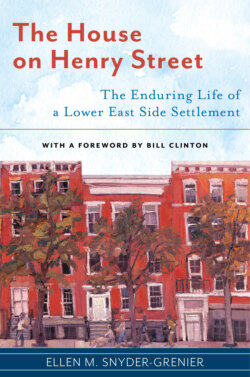The House on Henry Street

Реклама. ООО «ЛитРес», ИНН: 7719571260.
Оглавление
Ellen M. Snyder-Grenier. The House on Henry Street
CONTENTS
FOREWORD
INTRODUCTION
1. A BAPTISM OF FIRE
FACING A PANORAMA OF PROBLEMS
“WE HAVE SEEN AMONG OUR NEIGHBORS MANY HARROWING THINGS”: TAKING ACTION
THE SETTLEMENT’S FORMAL WORK BEGINS
“BAO” AND THE FOUR BRANCHES OF USEFULNESS
The First Branch
The Second and Third Branches
The Fourth Branch
FIGHTING FOR THE RIGHTS OF IMMIGRANTS
FIGHTING FOR THE RIGHTS OF WORKERS
FIGHTING FOR THE RIGHTS OF CHILDREN
FIGHTING FOR THE RIGHTS OF WOMEN
FIGHTING FOR THE RIGHTS OF BLACK AMERICANS
TAKING STOCK AT 20: THE 1913 PAGEANT
ART + ACTIVISM
HOMEFRONT CHALLENGES AND POSTWAR PROBLEMS
THE 1920S: END OF AN ERA OF PROMISE
2. MOVING WITH THE TIMES
FOREBODING AMONG OUR NEIGHBORS
RISING PROBLEMS
THE ARTS AND SOCIAL ACTION
THEN CAME THE WAR
WAR’S END, AND BIG CHANGES
BATTLING JUVENILE DELINQUENCY IN AN UNSETTLED NEIGHBORHOOD
Mobilization for Youth
A CITY IN CRISIS, THE WAR ON POVERTY, AND HELEN HALL’S PARTING WORDS: “I TOLD YOU SO”
3. LASTING NEIGHBOR AND STEADY INFLUENCE
SETTLING AT THE HOUSE ON HENRY STREET—AND SHAKING THINGS UP
Making Inclusivity Visible
A BOLD STATEMENT
PROBLEMS—BOTH INTERNAL AND EXTERNAL—ARISE
A Perfect Storm
Tackling AIDS, Resurging Homelessness, and the Impact of Rising Crime
SAVING THE SETTLEMENT
HENRY STREET IN THE 21ST CENTURY
Looking Back, and Moving Forward
CONCLUSION
PART 2: MOVING WITH THE TIMES
PART 3: LASTING NEIGHBOR AND STEADY INFLUENCE
CONCLUSION
Отрывок из книги
THE HOUSE ON HENRY STREET
The Enduring Life of a Lower East Side Settlement
.....
New York
A number of issues and ideas run through all these parts, many of them seesawing through time: about changing attitudes toward poverty and how to address it; about who is worthy of support; about professionalization and the role of gender and ethnicity; and about whether the Settlement’s arts programs were geared more for a downtown or an uptown crowd. Many of these issues are unnervingly similar to those that face America at the close of the second decade of the 21st century. You can hear the anti-immigration vitriol of the late 1800s in the cries for a wall on America’s southern border in 2019. You can feel the 1930s’ disappointment over the failure to pass universal health care in the fights over coverage today. And you can feel the anger over Gilded Age income inequality in today’s tensions over the rise of the one percent.
.....